Here’s a fun fact: Australia is one of the countries with the most native species of plants.
That diversity includes the many, many native Australian flowers that you can find from the rainforests to the coasts. The iconic golden wattle? Stunning native pea flowers? Spikey hakeas? We’ve got them all!
Counting the number of native flowering species would be harder than counting the petals on an Illawarra flame tree. So we’ve collected some of our favourite Australian native flowers – shrubs, trees, grasses, and more.
Australian Native Flowers List
Why Grow Native Australian Flowers?
More and more people are turning to Aussie natives to grow in their gardens, and for good reason!
Native plants are perfectly suited to our local climate and environment. Many natives are drought-tolerant and so need less water, often subsisting on just rainfall.
For native flowers, they play a key role in supporting local ecosystems and wildlife. These flowering plants provide food and habitat for all sorts of birds and beneficial insects.
Overall, native flowers and other plants are more low-maintenance and easier to care for!
NOTE: It is illegal to take cuttings or other plant material from native plants in public spaces or protected areas (such as national parks) unless state regulations grant a permit/license.
Australian Native Flowering Plants
These types of Australian flowers grow as shrubs, bushes, and other small to medium-sized plants.
That makes them perfect for growing along borders, in garden beds, or as accents. Many can be grown indoors, too!
Aussie box
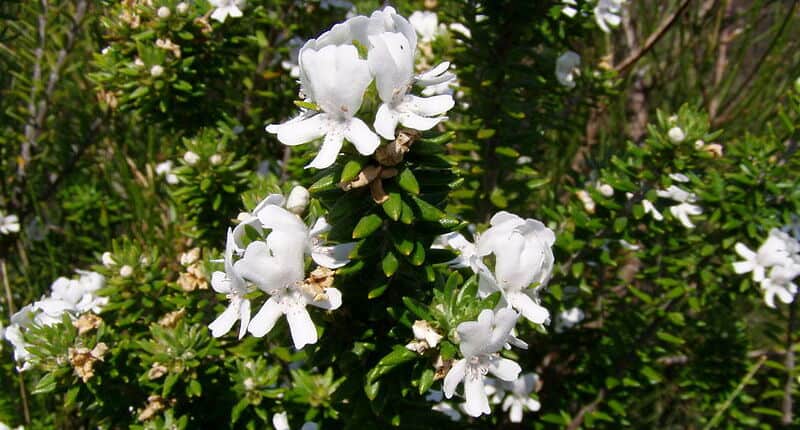
Size: Up to 1m without pruning
Flowering period: Spring and summer
Best for: Hedges or borders
Westringia plants are native Aussie shrubs that are members of the mint family. The Westringia hybrid Aussie Box is an Ozbreed cultivar and a great alternative to exotic box plants.
Aussie Box has gorgeous mauve and pink flowers from spring to summer. This compact shrub has dense foliage and small leaves, so it’s a good native plant for hedging.
Grow your Aussie Box in full sun and well-draining soils – no soggy or wet feet! As a plus, this hardy native flower can grow in coastal areas, since it can tolerate salt.
Billy buttons
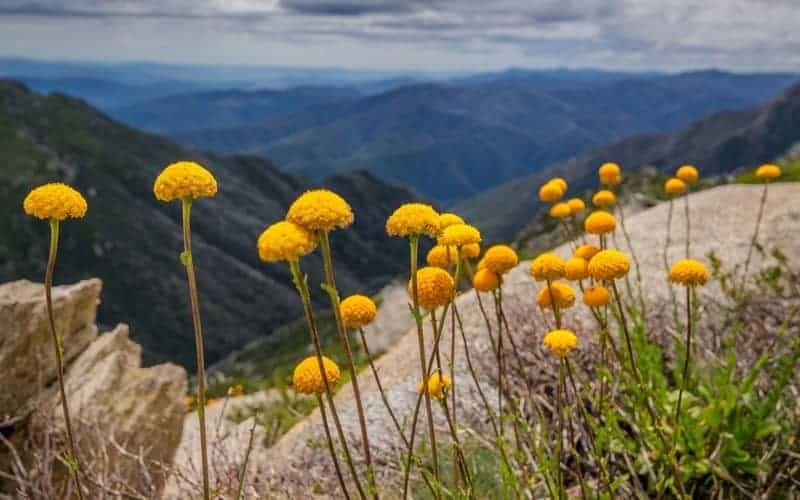
Size: 0.1-0.7m
Flowering period: Spring to early summer
Best for: Indoors, pots, or in-between plants
These gorgeous Australian wildflowers bring cheer everywhere with their bright yellow blooms!
The candy-like billy buttons (Pycnosorus globosus) are perennials that grow in most climates. These sun-loving flowers are excellent cut flowers for a bouquet or floral arrangement.
Billy buttons are fast growers and may need deadheading after flowering. They can grow in dappled shade and most soil types, so long as it’s not too acidic.
NOTE: These used to be classified as Craspedia globosa, so if you see Craspedia plants – those are billy buttons!
Canberra bells

Size: Up to 1.0m
Flowering period: Autumn to early winter
Best for: Pots, mixed beds, or feature plants
If the name doesn’t give it away, these Correa flowers are significant to Australia’s capital. Correa ‘Canberra Bells’ was cultivated to celebrate Canberra’s centenary in 2013!
Canberra bells is a native fuchsia that can tolerate drought, frost, and part shade. It’s iconic for the unique, two-toned red and cream flowers shaped like (you guessed it!) bells.
Trim your Canberra bells plant after flowering to maintain its shape, and give it some extra water during hot or dry months. Expect lots of garden visitors since birds and bees love their blooms!
Egg and bacon plant
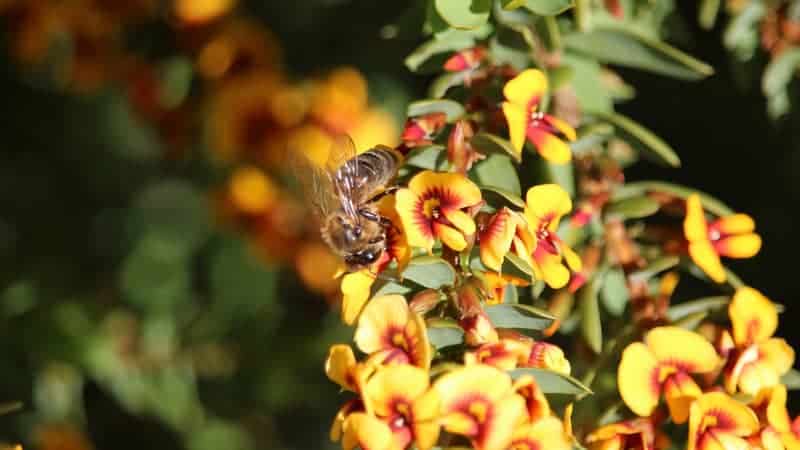
Size: 0.5-1.0m
Flowering period: Spring
Best for: Informal hedges, pots, and mixed garden beds
Either someone was hungry when this plant was named, or we just love our brekky.
Still, it’s easy to see where the name comes from! The wide yellow petals and reddish-brown centre invoke a playful eggs-and-bacon image.
The egg and bacon plant (Eutaxia obovata) is a compact, dense shrub native to Western Australia. It grows best in partial to dappled shade and prefers moist, free-draining soil.
E. obovata can tolerate drought and salt, but avoid growing it in alkaline conditions.
Flannel flower
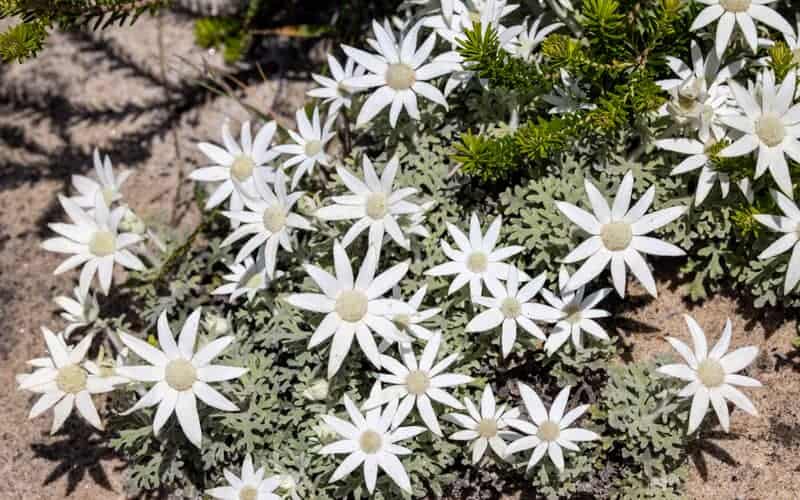
Size: 0.5-0.9m
Flowering period: Year-round, peaks in spring
Best for: Borders, containers, or mass planting
No, these flowering plants don’t look like that shirt we all have in our closets. The flannel flower (Actinotus helianthi) is a native shrub with white flowers that feel soft and “woolly.”
Flannel flowers are particularly common in Sydney, but grow along the south-east coast of Australia. The plants prefer moderately acidic, sandy soil and lots of sun.
If you grow flannel flowers in your garden, keep them out of strong winds – the stems are pretty delicate!
Grevilleas

Size: Up to 2.0m for shrubs
Flowering period: Winter to spring
Best for: Depends on species; ground cover, shrubs, or trees
Grevilleas (Proteaceae) are popular plants around Australia! Most species are small shrubs, but there are also grevillea trees and groundcover plants.
Grevillea flower spikes come in a range of colours, from electric yellow to vibrant pink. They love sunlight and need soil that’s slightly acidic but low in phosphorus.
One of the most popular species is the Grevillea banksii, with its iconic bright red flowers. It has a longer flowering time than most grevilleas and works best as a screening plant.
Fun fact: grevilleas are cousins to banksias, hakeas, and South African proteas!
Heart-leaf flame pea

Size: Up to 1.0m
Flowering period: Winter to spring
Best for: Borders and other shaded areas
These Chorizema native flowers take their name from their vivid orange-and-purple blooms!
The heart-leaf flame pea is a great flowering native plant for dry shade, adding colour to the less sunny spots of your garden. The shade helps protect the delicate petals from scorching.
Combined with the evergreen heart-shaped foliage, Chorizema is a good ornamental plant. Tip pruning and well-drained soil ensure masses of lush flowers.
Grow Chorizema plants in well-draining soil or potting mix. The heart-leaf flame pea prefers temperate to Mediterranean climates.
Kangaroo paws
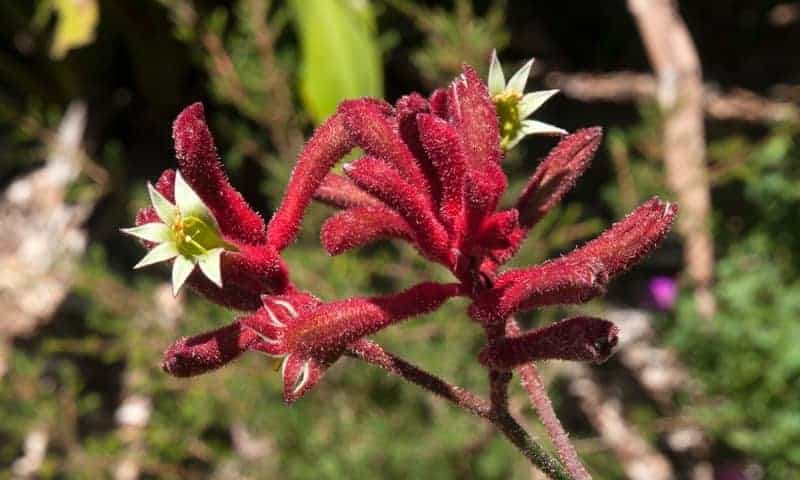
Size: 0.4-1.0m
Flowering period: Late winter to spring
Best for: Borders, mixed beds, or rockeries
The floral emblem of Western Australia is easy to spot – just look for brightly-coloured flowers shaped like kangaroo paws.
Australia’s kangaroo paw plant (Anigozanthos) is pretty unique, with leafless stalks and a slightly fuzzy texture. It thrives in sunny spots and well-drained sandy soil.
Most kangaroo paw varieties grow best in temperate climates without any frost. A few varieties can tolerate subtropical climates, but kangaroo paws generally don’t like humidity.
NOTE: There’s only one kangaroo paw variety that’s not Anigozanthos! If you can find the rare black Macropidia (Black Kangaroo Paw), it’ll be the envy of all your gardening friends.
Native violets
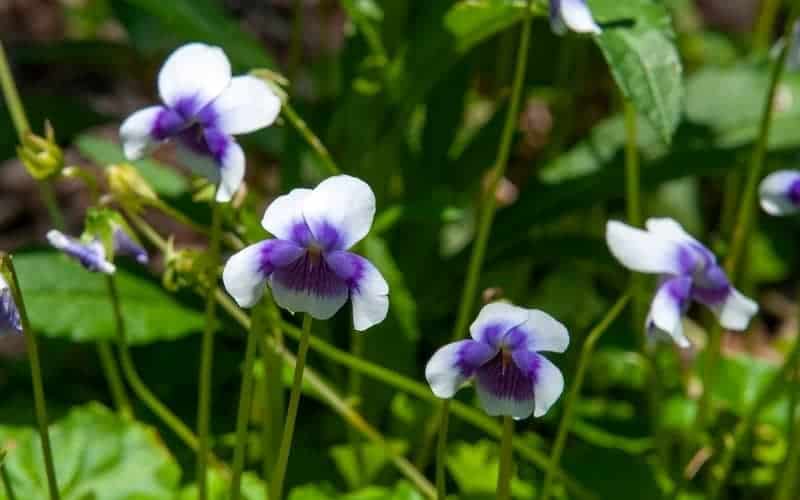
Size: 0.1-0.4m
Flowering period: Year-round
Best for: Groundcover, hanging pots, or low-traffic lawns
If you want colour all throughout the year, grow some native violets! Viola banksii is a hardy and low-maintenance plant that puts out striking violet-and-white flowers.
V. banksii is native to the east coast of Australia, so it can grow in subtropical or temperate climates. The flowering plant likes sun but does fine in partial shade.
It prefers moist soils but can tolerate drier conditions with extra watering. Don’t worry if you see it dying back – it’ll regrow from underground runners.
NOTE: You can grow V. banksii as a lawn substitute in low-traffic areas.
Pink heath
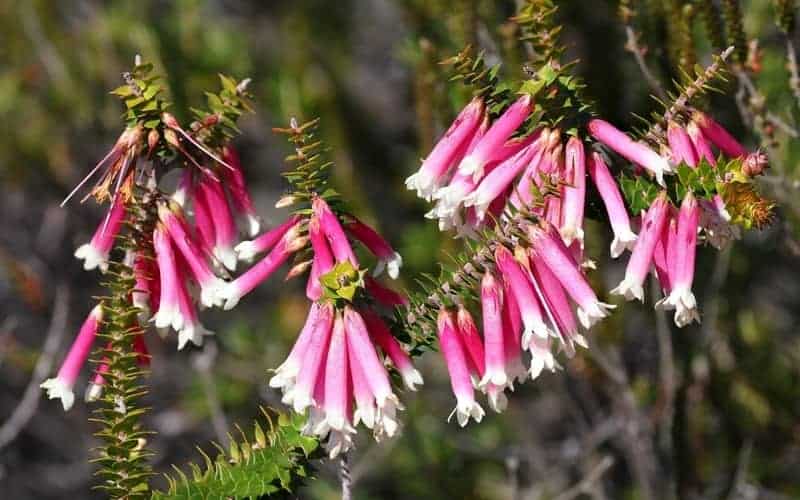
Size: 1.0-1.5m in cultivation
Flowering period: Late autumn to early spring
Best for: Pots, rockeries, and small garden beds
This is the pink variation of the common heath (Epacris impressa) and is the floral emblem of Victoria! (It was one of the first floral emblems adopted by a state, in the 1950s.)
Pink heath is one of the most iconic Victorian native flowers, thanks to the showy clusters of bell-shaped blossoms. The nectar attracts plenty of birds, bees, and other insects.
E. impressa prefers moist, slightly acidic soil and full sun to semi-shade. Pink heath is also a good potted flowering plant – just make sure to get a well-draining potting mix.
One downside, though: pink heath is a short-lived plant.
Pink rock lily
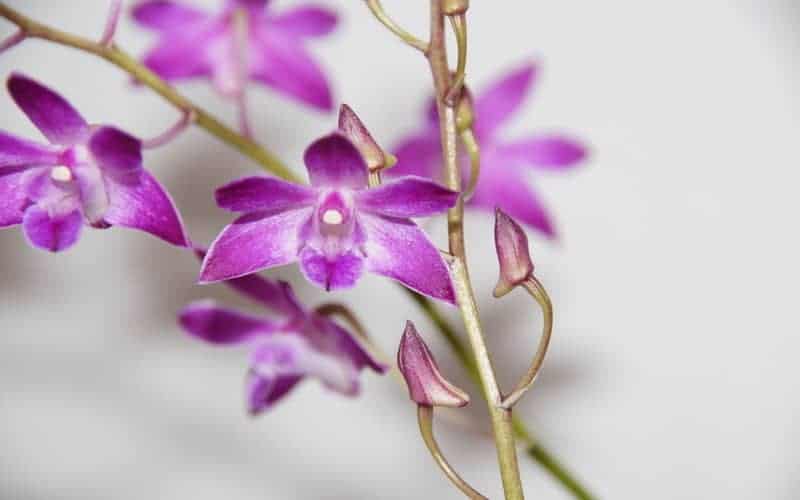
Size: 0.5m
Flowering period: Late winter to spring
Best for: Rockeries, mixed gardens, or containers
Also called the pink rock orchid, Dendrobium kingianum is a “lithophyte” in the wild – meaning it grows on rocks, hence the name! Pink rock lilies are one of the most popular native orchids in Australia.
The pink rock lily has flower spikes with up to 12 scented blooms on each spike. It’s a low-maintenance orchid, able to tolerate dry periods since its root systems hold onto moisture well.
D. kingianum needs cool weather to produce flowers, but doesn’t do well in temperatures 2ºC and below. It thrives in sunny spots and medium to high humidity in spring and summer.
When grown indoors, use a chunky orchid mix with plenty of bark and a shallow pot.
Sturt’s desert pea
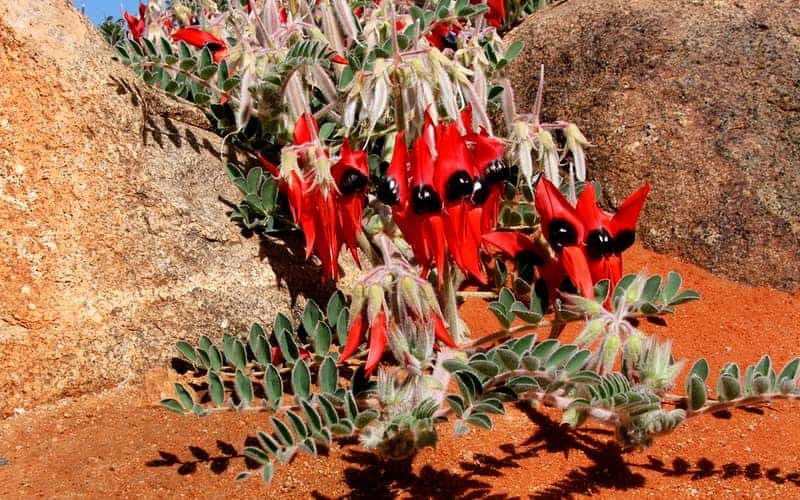
Size: 0.3-0.5m
Flowering period: Late winter to spring
Best for: Rockeries, containers, or hanging planters
Say hello to the floral emblem of South Australia! You’ll know Sturt’s desert pea (Swainsona formosa or Ngooringa) by its large, eye-catching red flowers with a black pea-like centre.
As its name suggests, Sturt’s desert pea is well-adapted to growing in desert conditions. However, this makes it difficult to grow in home gardens, especially in cool climates.
It grows best in gritty potting mixes or sandy soil with perfect drainage. Be careful when watering as Sturt’s desert pea can be prone to root rot or fungal diseases.
Violet kunzea
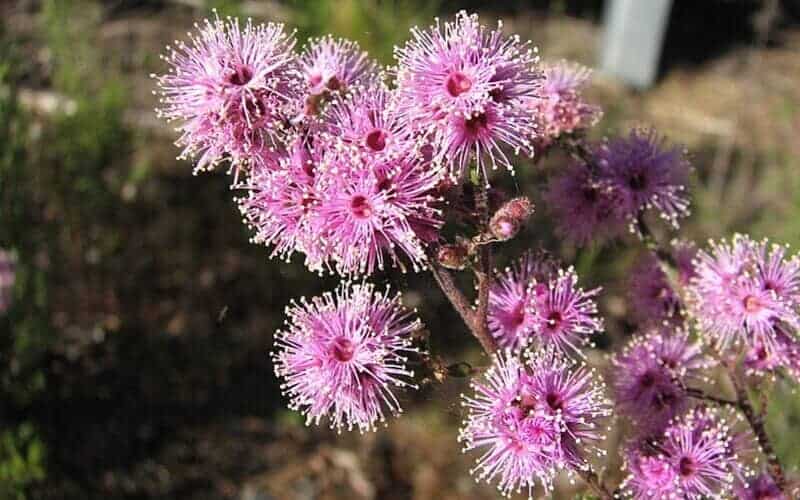
Size: Typically 1.0m in cultivation
Flowering period: Mid-spring to summer
Best for: Rockeries, houseplants, or borders
If you want to fill your garden with flowers that look and smell good, opt for violet kunzeas (Kunzea parvifolia). You’ll get showy purple-to-pink flowers that look like small fireworks, with a sweet scent.
In the wild, kunzea plants grow primarily in New South Wales and Victoria.
Violet kunzea is a small, upright shrub that prefers temperate and Mediterranean climates. It’ll grow best in full sun and moist, well-drained soil that’s slightly acidic.
Fun fact: Violet kunzea and other kunzea plants produce nectar used to make the rare but delicious Kunzea Honey!
Waratah
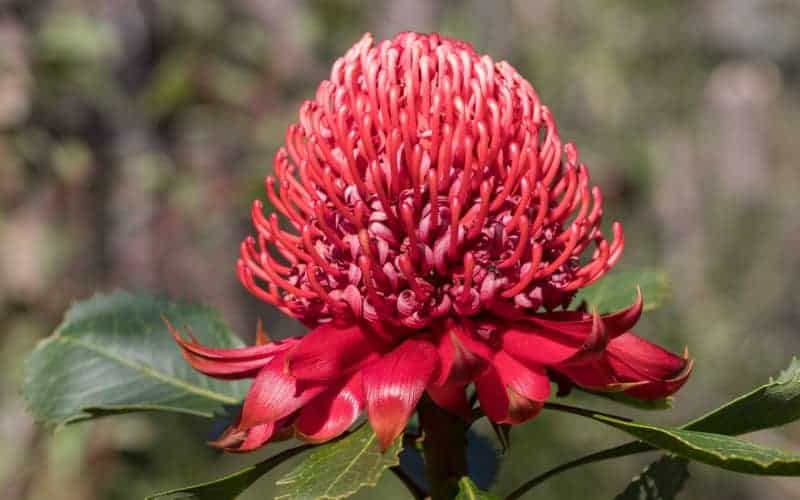
Size: Up to 4.0m as a shrub
Flowering period: Spring to early summer
Best for: Feature plants or hedging
The beautiful waratah (Telopea) is probably one of the most iconic Australian native flowers. The most popular and recognisable is the New South Wales waratah, which is also the state’s floral emblem!
There are four other waratah species: Gibraltar, Monga, Victorian, and Tasmanian.
NSW waratah shrubs produce cherry-red flower clusters, while other varieties can have pink, yellow, or (very rarely) white flowers. The blooms are easily scorched, though, so waratah prefers dappled or semi-shade.
NOTE: When grown from seed, waratah can take up to 5 years to begin flowering.
Wax flowers
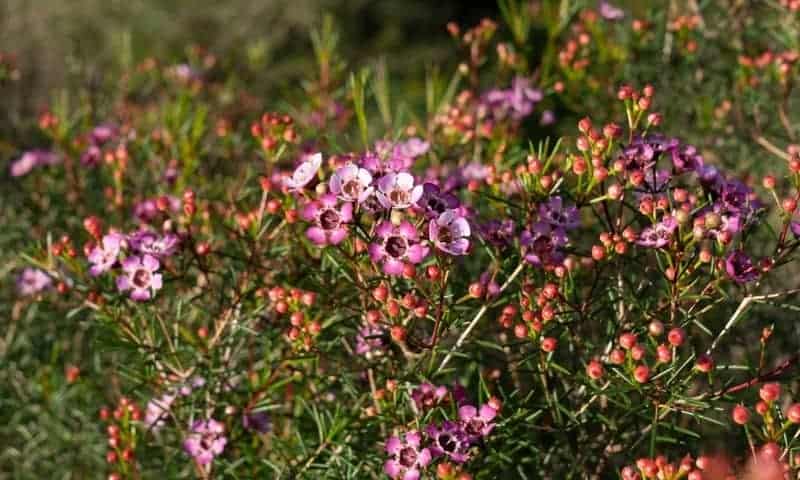
Size: Up to 3.0m
Flowering period: Winter to early spring
Best for: Hedging, screen plants, or containers
Remember how you would draw flowers as a kid? Colour them pink or purple and that’s what wax flowers look like!
Chamelaucium plants are native to Western Australia, where they thrive in coastal areas. Wax flowers get their name from the waxy feel of the petals, which give off a sweet aroma when crushed.
These flowering plants prefer sunny spots with free-draining soils and low humidity. The most commonly cultivated variety is the Geraldton Waxflower, while the biggest is Megalopetalum.
Australian Native Flowering Trees
Make a statement in your garden and help your local ecosystem with these flowering Australian native trees.
Banksia
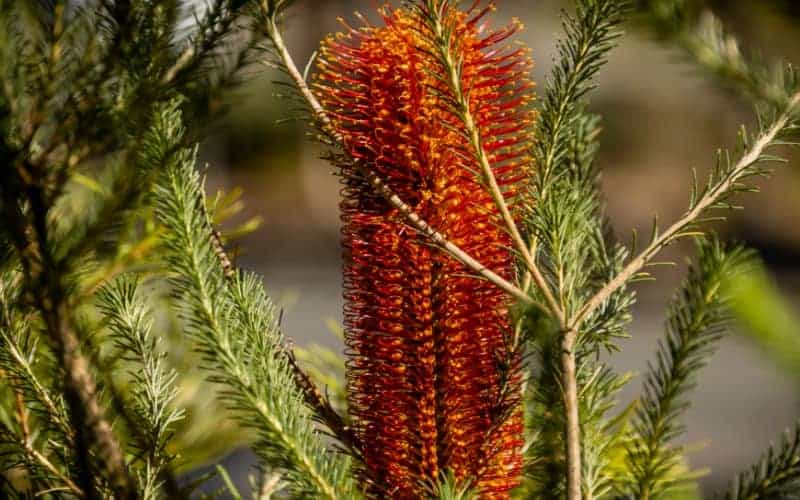
Size: Up to 25m (tree)
Flowering period: Commonly autumn to winter
Conditions: Slightly acidic soils, plenty of sun
Sometimes called Australian honeysuckle, there are over 100 species of banksia – with most of them found in Western Australia.
Banksias have chunky, cylindrical flowers with “spikes.” Some popular varieties to grow include Banksia ‘Giant Candles’, Coast Banksia, and Banksia ‘Birthday Candles’.
Typically, banksias thrive in well-drained soils that are slightly acidic and low in phosphorus. If you grow one in your yard, know that banksia trees can live a long time (up to several decades)!
Bottlebrush
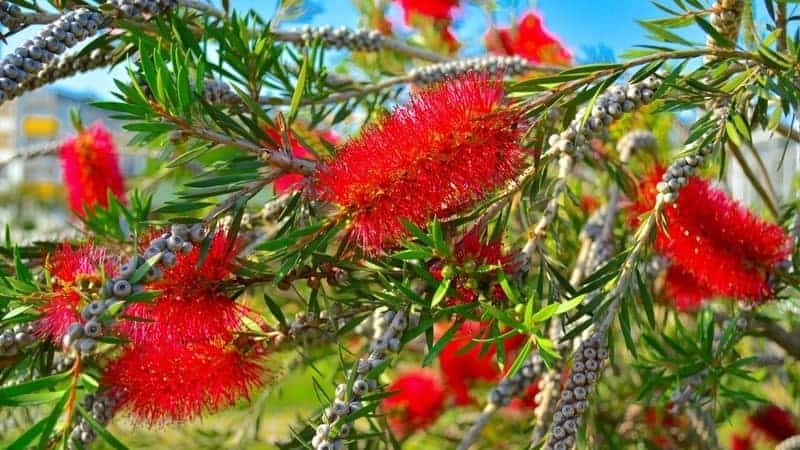
Size: Up to 2m (shrub) or 10m (tree)
Flowering period: Spring to autumn
Conditions: Moist soils, plenty of sun
No prizes for guessing how bottlebrush (Callistemon) got its name – those vibrant flowers look like bottle brushes! They come in a range of colours, from pinks to whites.
Bottlebrushes are common flowers in Australia, growing in damp conditions everywhere from the Northern Territory to Tasmania. The only places they don’t thrive are dry or frosty climates.
The best-known bottlebrush shrub is the Crimson bottlebrush, which is often grown as hedging or borders.
Eucalyptus
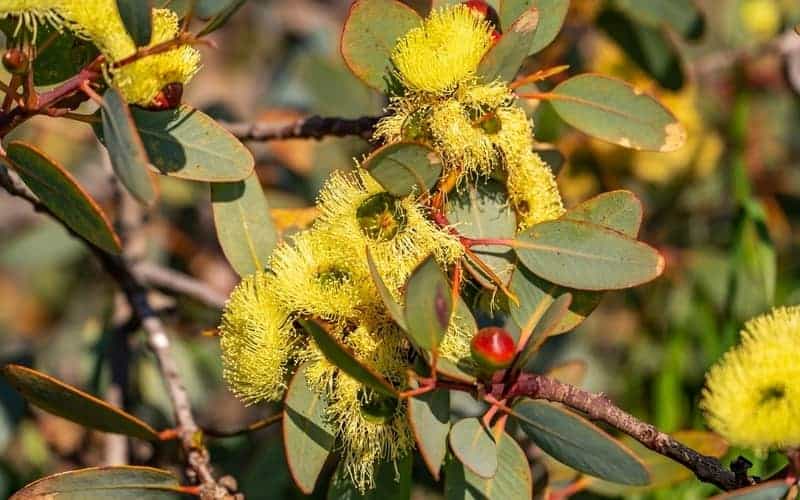
Size: Up to 8m for cultivated varieties
Flowering period: Summer to autumn
Conditions: Well-draining soil, full sun
Eucalyptus trees, alongside Corymbia and Angophora, are commonly known as gum trees. They’re popular for their blue-grey foliage and the stunning fluffy flowers that come in all shades – pink, red, cream, you name it!
Most eucalyptus trees grow over 50m in the wild, but trees cultivated for gardens typically only reach 6-8m. One of the more popular varieties (and early bloomers) is Eucalyptus caesia, or the Silver Princess Eucalyptus.
Gum trees can grow in most climates so long as they get about 6 hours of sun per day. They can tolerate a range of soil conditions except high phosphorus levels.
Hakea
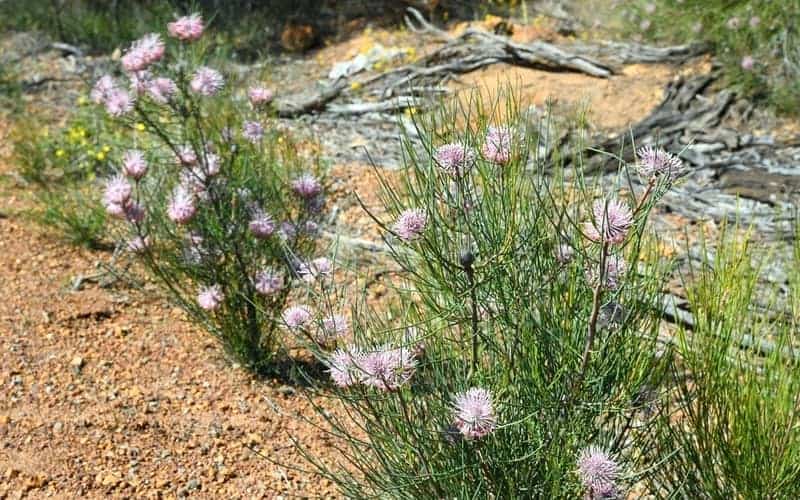
Size: Up to 9m
Flowering period: Winter to spring
Conditions: Well-draining soil, full sun
You’ll know these no-fuss native flowering trees by their flowers: dark-coloured balls with needle-like protrusions, like a pin cushion!
There are over a hundred Hakea species in Australia, from the red-and-white Hakea laurina to almost-indestructible Hakea salicifolia.
Nicknamed needle-bush, Hakea trees need low-phosphorus soils with plenty of organic mulch. Hakeas grow best in medium-dry conditions with lots of sun.
Illawarra flame tree
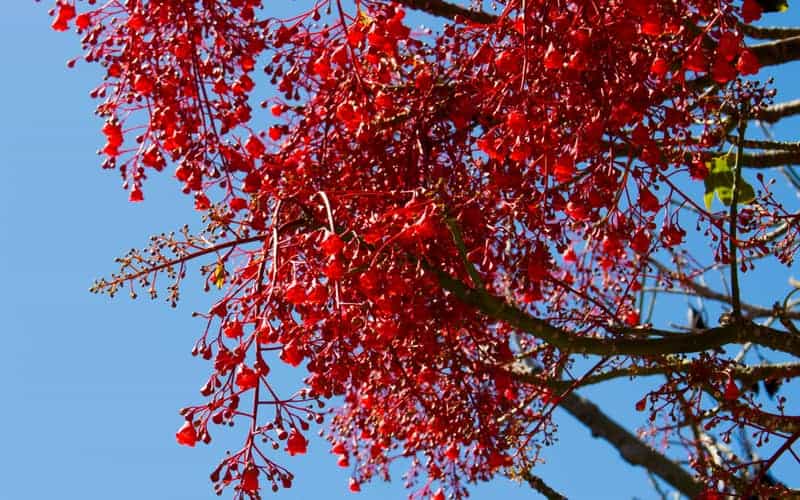
Size: Up to 10m
Flowering period: Late spring to summer
Conditions: Most soil types, full sun to semi-shade
The Illawarra flame tree (Brachychiton acerifolius) makes a fiery impression when its bright red, bell-shaped flowers burst into bloom.
As a native Australian deciduous tree, it’s unique since it loses its leaves before flowering. The lack of foliage makes the flowers stand out even more during their season.
In the wild, Illawarra flame trees grow in subtropical rainforests in New South Wales and Queensland. They have invasive root systems, though, so should not be grown close to a structure.
NOTE: These native trees don’t flower every year! They’re more likely to put out blooms after a hot, dry summer or a dry winter.
Lilly Pillies
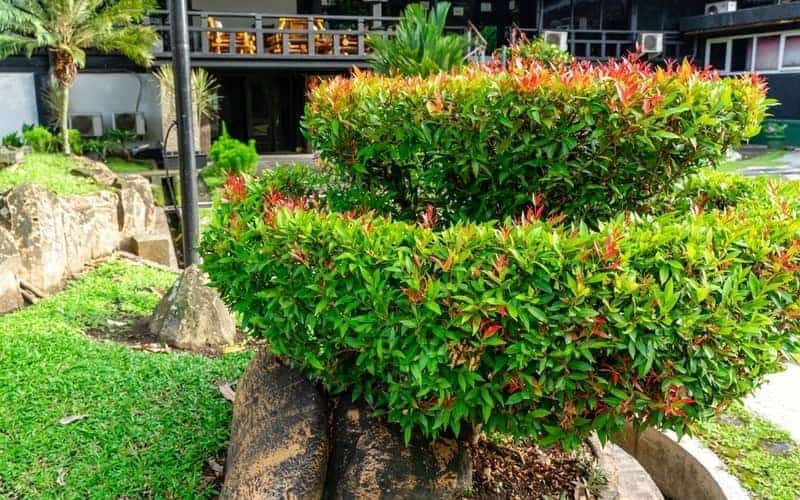
Size: Up to 5m for shrubs, 30m for trees
Flowering period: Spring to summer
Conditions: Rich soils, sun to semi-shade
There are many Lilly Pilly varieties in Australia, falling under 3 species: Acmena, Syzygium and Waterhousea. One of the more popular Lilly Pillies is Syzygium australe, also known as Australian cherry or bush cherry.
And yes, most Lilly Pilly fruits are edible!
Lilly Pillies have dense foliage and glossy, oval-shaped leaves. The flowers tend to be small but light and fluffy – like tiny pom-poms.
Watch out for psyllid infestations though, especially with Lilly Pilly hedges.
Native frangipani

Size: Up to 15m
Flowering period: Spring to summer
Conditions: Rich and moist soils, sun to light shade
Native frangipanis (Hymenosporum flavum) are popular backyard trees thanks to their sweet-smelling yellow flowers.
They grow primarily in rainforests in NSW and QLD, so grow best in well-watered soils and lots of sun. Still, they’re hardy enough to tolerate drier climates if you can provide consistent moisture.
Make sure you get the native frangipani and not the exotic Plumeria frangipani trees – those aren’t endemic to Australia.
Wattle

Size: Up to 10m
Flowering period: Late winter to spring
Conditions: Acidic soils, plenty of sun
Say hello to one of the most popular plants down under – the wattle!
The ACT’s golden wattle is probably the most iconic with its sunshiney blooms, and is Australia’s national flower. Other wattles can be cream or white, while less common varieties are pink or red.
The wattle (Acacia) can tolerate most soil types as long as there’s good drainage, though they prefer slightly acidic soils. Avoid growing wattles in areas with very cold winters or heavy rains.
NOTE: Choose your wattle varieties carefully – many are invasive outside their native ranges!
Australian Native Flowering Grasses and Ground Cover
There are several Australian native grasses and groundcover plants that have flowers!
These plants are great for no-mow lawns and other lawn alternatives, thanks to their low-water and low-maintenance needs.
Australian daisy
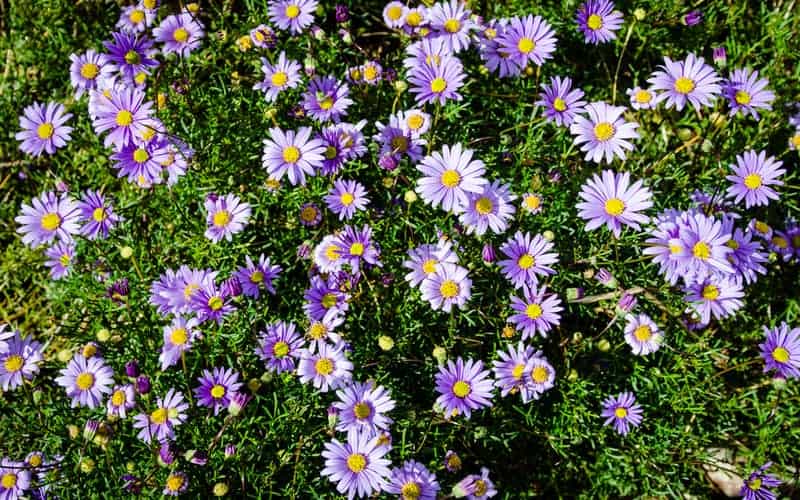
Size: 0.3-0.5m
Flowering period: Spring, but can flower intermittently year-round
Best for: Pots, borders, or around pavers
There are about 1000 species of Australian daisies (Brachyscome genus), so we can’t list them all!
Most native daisies are perennials, with delicate foliage and a low growth habit. The flower colours can range from vibrant purple to bright white.
(If you’re lucky, you’ll find a Brachyscome iberidifolia – Swan River daisy – in blue!)
Australian daisy loves full sun but can tolerate part shade. It grows in most soil conditions (even slightly alkaline) so long as there’s moderate drainage, and can tolerate mild frost.
These flowers are perfect for dried flower arrangements.
Blue flax lily

Size: Up to 1.2m without mowing
Flowering period: Spring to summer
Best for: Shady areas, mixed landscapes, or borders
Blue flax lily (Dianella longifolia) is a hardy, low-maintenance native grass that can grow in most climates except tropical. It tolerates a wide range of soil conditions so long as there’s good drainage.
This flowering native grass is great for water-wise lawns and landscapes since it’s so drought-tolerant. It can also be cut back hard since it regrows easily from underground rhizomes.
Blue flax lily is ideal for sloped gardens since it’s useful for erosion control!
Desert flame
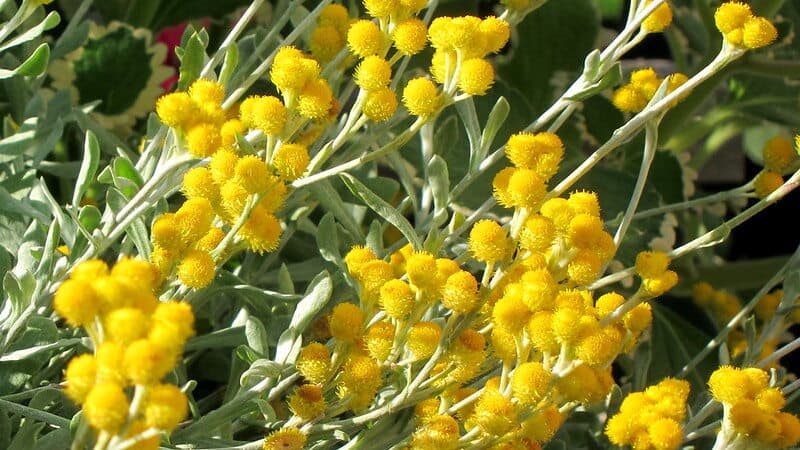
Size: 0.15-0.3m
Flowering period: Spring to autumn
Best for: Rockeries, mass planting, or garden beds
Desert flame is a cultivar of Chrysocephalum apiculatum that’s as fiery as its name suggests. When mass-planted, expect a carpet of yellow Australian native flowers.
This perennial herb can grow in a wide range of environments, but prefers temperate climates and sunny spots. C. apiculatum is good for filling large spaces, while the blossoms are good for bouquets.
Desert flame plants are also ideal Australian wildflowers for no-mow native gardens.
Fan flowers
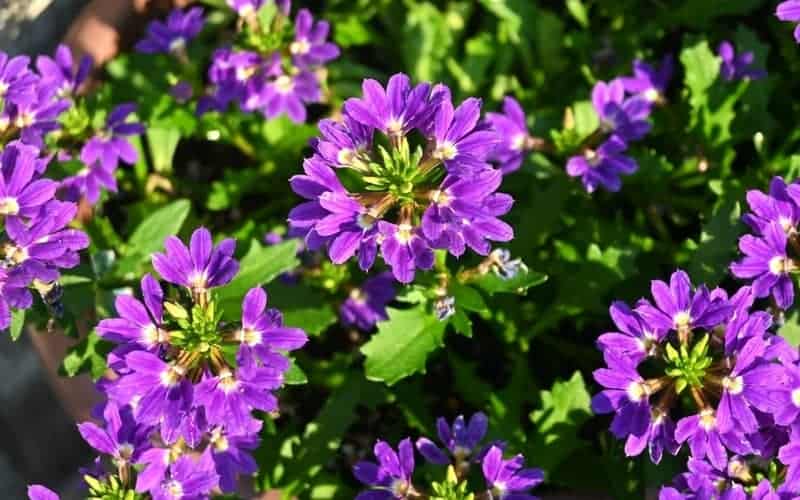
Size: 0.3-0.8m
Flowering period: Spring to autumn
Best for: Mass planting, containers, or hanging baskets
There are dozens of fan flower (Scaevola) species in Australia, mostly on the eastern side. The fan-shaped flowers come in purple, mauve, even white – and rarely, yellow.
Fan flowers are growing in popularity as groundcover plants since they’re quite hardy. They grow best in full sun, free-draining soil, and consistent moisture.
When mass-planted, fan flowers are prolific bloomers and will cover large spaces with plenty of colour. They’re quite short-lived but can be easily propagated from cuttings!
Pig face plant
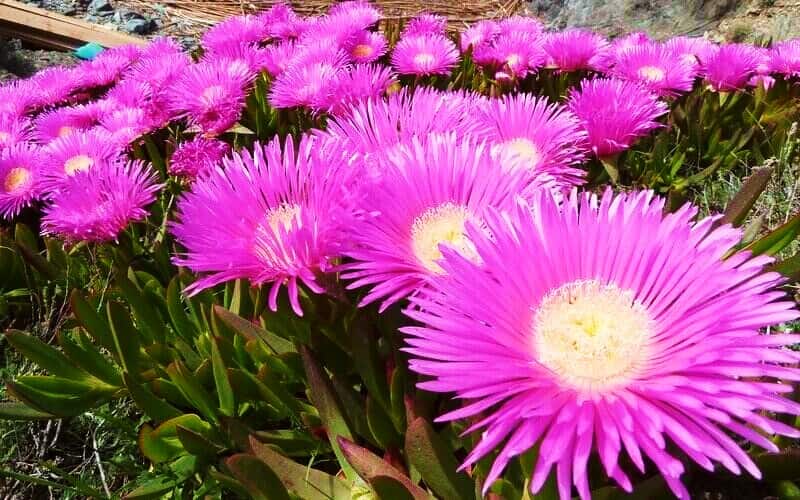
Size: 0.2m
Flowering period: Spring to summer
Best for: Mass planting, rockeries, or sloped areas
Have you seen a chunky succulent with bright pink flowers? That’s Australia’s native Carpobrotus, commonly known as the pig face plant.
Pig face succulents are recognisable thanks to their tube-link, blue-green leaves. Most parts of the plant are edible – the leaves can be roasted, while the fruits are slightly salty.
These flowering succulents are common in coastal areas, so they grow best in sandy soil and lots of sun. Too much moisture will cause rot, so they’re better off in dry conditions.
NOTE: Like aloe, the juice from pig face leaves can soothe mild burns or stings!
Swamp foxtail

Size: 0.5-1.0m
Flowering period: Spring to autumn
Best for: Rockeries or borders
Swamp foxtail (Pennisetum alopecuroides) is a native tussock with a dense growth habit. The feathery flowers add an interesting texture when grown in clumps.
This native Pennisetum prefers moist soils, but can grow in a wide variety of growing conditions. It can be cut back hard to encourage new growth – time it well, and you can use swamp foxtail as dried flowers!
Choose cultivated varieties that aren’t self-seeding, since swamp foxtail can spread quickly.
NOTE: Be sure to get the native Australian Pennisetum and not the African species – that’s a weed!
Trigger grass
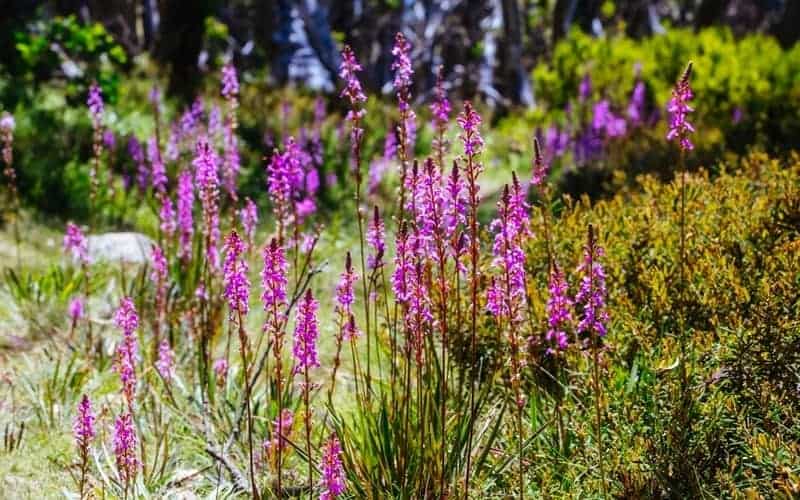
Size: 0.2-0.7m
Flowering period: Late winter to spring
Best for: Rockeries, small gardens, or containers
Trigger grass or the grass-trigger plant (Stylidium graminifolium) gets its name for an interesting reason. When insects land on the flowers, they “trigger” the plant, which smacks them on the back with pollen.
Yes, really.
Despite the aggressive pollination, the mauve flowers of trigger grass look quite delicate, especially against the blue-green foliage.
Trigger grass grows best in gravelly, free-draining soil and sunny conditions. It’s low-maintenance once established and can tolerate drought, frost, and salt.
FAQs About Flowers Native to Australia
Here are some quick answers to common questions about native Australian flowers.
What time of year do Australian natives flower?
Flowering season is different among native Australian flowers! Generally, though, native plants will flower sometime between late winter to early summer.
Peak wattle season, for example, is in the last weeks of August to the first weeks of September. On the other hand, Canberra bells are at their peak in March.
Are Australian native flowers toxic to cats?
Some Australian native flowers are toxic to cats and dogs. Kangaroo Paws and Illawarra flame trees can cause gastrointestinal or skin irritation.
Meanwhile, wattle seeds and bark can be toxic if licked or ingested. Cats and dogs may also be allergic to grevillea flowers.

